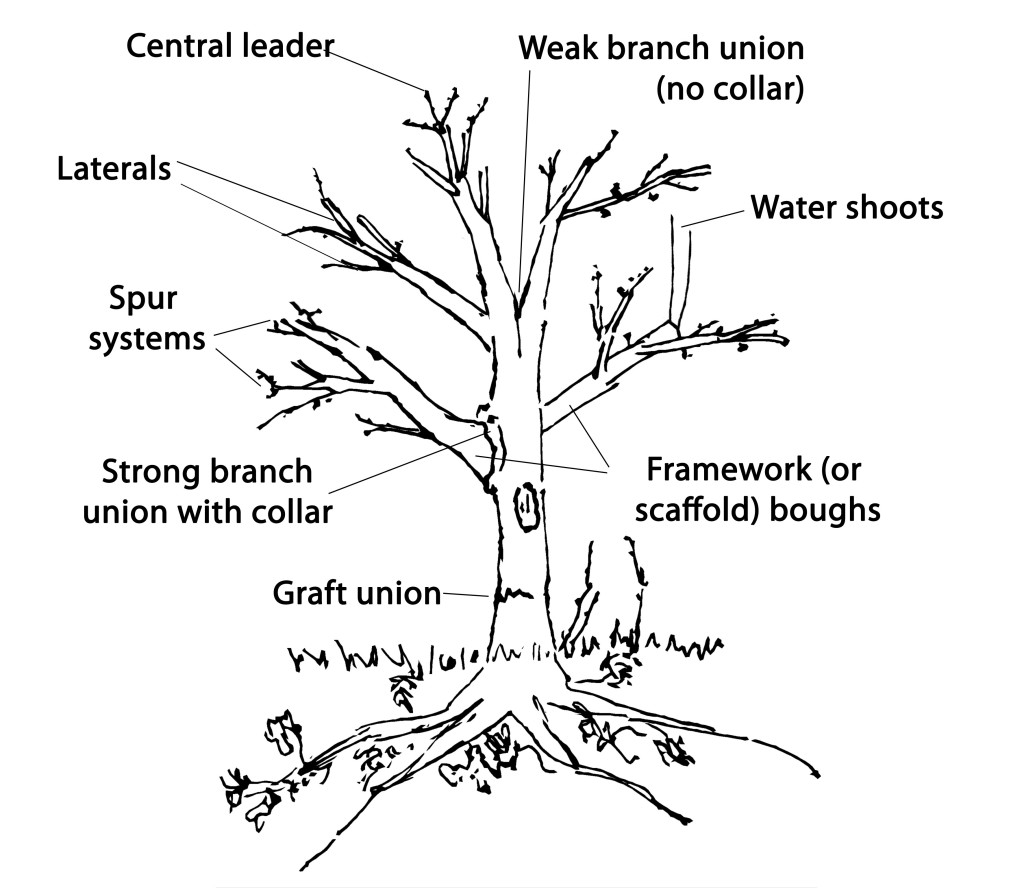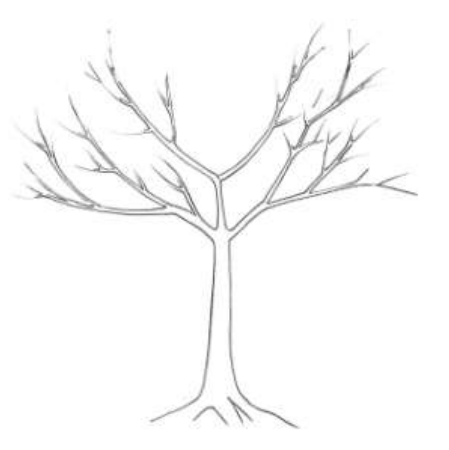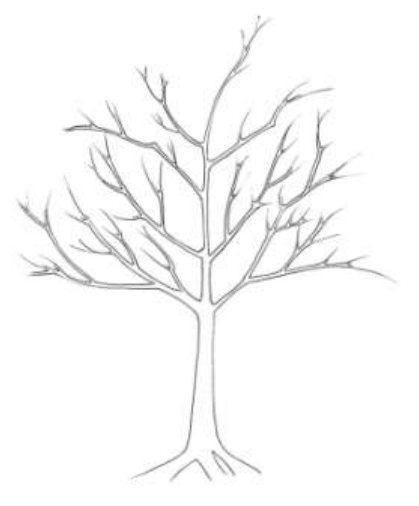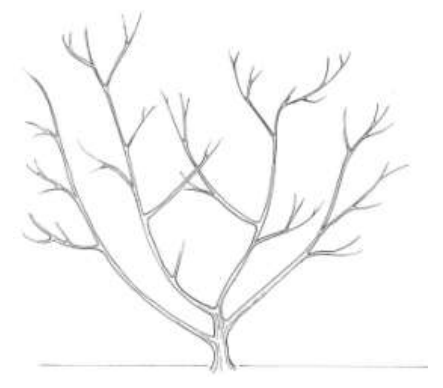Formative pruning trees
Formative pruning is the process of shaping a tree when it is young. Every variety has a different natural growth habit, but unpruned fruit trees will for the most part produce a crown cluttered with branches so yielding smaller, lower quality fruit. The aim is to develop an open, balanced network of strong, unshaded branches that will support heavy fruit crops, and at a height that allows for good orchard management such as grazing livestock and machinery. This is achieved by creating a good height trunk and pruning young growth back to encourage the tree to grow in the right direction and develop thick branches.
The desired shape, methods and amount of shaping depend on the type of fruit tree and the vigour of the rootstock. Stone fruit (cherry, plum etc.) does not respond as well as apples and pears to pruning so need less work.
Creating the tree shape
By selection and removal of material, a permanent framework can be established that will determine the final shape and height of the tree. When deciding what growth to keep or remove, consider the tree in three sections. 1) The main stem, or trunk, connects to 2) the framework branches which in turn hold 3) the lateral branches. The framework branches are the major limbs which are usually retained for long periods, if not the entire lifetime of the tree. The smaller laterals, or side branches, will bear leaves and fruit and are pruned and renewed on a more regular basis, mostly through summer pruning.

This is the most important period of pruning during the tree’s life. If neglected the tree will produce a smaller crop and require later corrective work. Young trees that are not pruned may develop thin, vertical, overcrowded, crossing and badly placed branches affecting yield and mechanical strength. The ideal is to create strong, well-spaced laterals (horizontal branches which will bear the leaves and fruit) to support the weight of the fruit and ensure it gets as much sun as possible to help the fruit ripen.
Before you start
It is important to know what form tree you are aiming to create. The style of tree shape traditionally varies across the country and between types of fruit. For example cider apples varieties are more traditionally grown with central leaders, but dessert varieties are often formatively pruned into more of a goblet shape, with open centers. The final desired outcome will dictate how to prune from the outset.
Creating the framework
Formative pruning concerns only the main stem and framework. Depending on how large you would like the resulting tree to be, select between 3 and 7 or 8 branches to form a permanent framework. Remove the rest. The lowest framework branch should start a little below the lowest picking height required. When selecting, consider that branches laden with fruit will sag and as the wood hardens it will remain permanently so. Every situation is different. A small garden tree will have low branches with fruit hanging barely off the ground, whereas an orchard managed with livestock or machinery will need sufficient clearance beneath the canopy. Make sure to remove any branches that are growing out of the rootstock below the grafting point and remove any fruit as it starts to develop until the framework is formed, or at least for the first couple of years.
The main aim of formative pruning is to develop well-spaced branches that will allow good air circulation and light penetration. It’s also important to select branches that join at a wide angle. These will form a stronger union with the parent branch which are less liable to split away under heavy fruit crops than narrowly angled branches.
During the formative stages thought should be given to the tree’s natural growth habit. Some varieties produce excessively upright growth. These benefit from tying down with string and pegs, tying weights to the branch, or wedging branches between the forks to force them into a more horizonatal plane. A horizontal branch fruits more readily than one growing upright.
Formative pruning for central leader trees
Formative pruning for open centered fruit trees
Restricting tree size
Trees on vigorous rootstocks live for the longest and are best for wildlife, but they might grow too tall for ease of picking or outgrow their space. Traditionally, cider apple trees are allowed to grow to their natural height as the fruit is shaken free and collected from the ground rather than picked, and trees grafted to dwarfing rootstock will be naturally restricted, but if your tree looks like it’s reaching for the stars or smothering neighbouring trees, you may wish to restrict its growth. There are several things that can be done to this end.
The first two techniques (below) are useful to restrict the height of the central stem or length of framework branches. They exploit the natural growth habit of plants by manipulating sap movement. The most vigorous growth is from the tips of branches, at the apical bud. The highest of these, normally in the middle of the tree, is known as the ‘central leader’. Side branches, called laterals, grow outward, away from the main stem. When a branch is pruned the next bud below the pruning cut will be promoted by the tree to be the apical point of that branch, so we trick the tree into thinking that everything is in order at the existing apical bud, but do something to slow down its dominance and force the tree’s energy into laterals farther along the branch. Techniques 3 and 4 are more drastic interventions suitable for restricting very high vigour.
Whichever method is used, the wounds should be covered with grafting wax or a non-toxic adhesive tape until callouses have formed to protect it from disease and insect damage.



